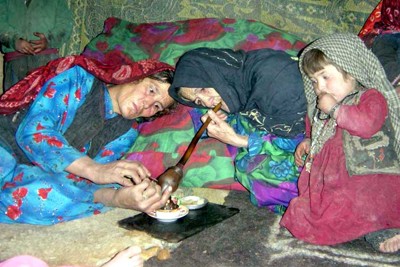By Soraya Sarhaddi Nelson
A growing number of Afghans — including children — are escaping the pain of war and poverty by using opium or heroin, for as little as a dollar a day.

A United Nations survey begun this month is widely expected to show that at least 1 in 12 people in Afghanistan abuses drugs
A United Nations survey begun this month is widely expected to show that at least 1 in 12 people in Afghanistan abuses drugs — double the number in the last survey four years ago.
Experts say that the alarming trend is not being addressed by the Afghan government and its international partners, even though most officials acknowledge that the drug scourge threatens lasting stability in Afghanistan.
Many of the addicts, especially the women, feed their habit in secret, inside walled, mud-floor family compounds.
An Afghan Mother Hooked
One addict, a woman named Karima, shares her home with her addicted parents and other relatives in a poor hillside neighborhood in Kabul. Local drug counselors say the neighborhood is home to thousands of addicts.
On a recent afternoon, Karima draws the curtains shut on the window of the room she shares with her six children. Her hands shaking, she pulls an old envelope out from underneath a plastic mat. Inside are opium pellets, which she smashes into an emptied cigarette casing and lights up.
"When I smoke this, I don't experience any unhappiness. My nerves calm down. If I don't do this I go crazy," Karima says.
Her young children suffer ill effects of being bathed by opium and heroin smoke since birth. They do not attend school.
The oldest is Fahima. At 12, she is the size of a child half her age. She has big brown eyes and bald spots on her head from malnutrition.
Fahima is the one her mother sends out to buy drugs to stoke her habit.
"My mom nags me to go get hashish and opium so she can be happy. If she doesn't use it, she gets angry and hits us all," Fahima says.
The soaring rates of drug abuse are driven in part by Afghanistan's widespread unemployment and social upheaval under the Taliban and the U.S.-led war, begun in 2001. Another factor is the flood of returning Afghan refugees from Iran, many of whom became heroin addicts there.
And fueling it all is an overabundance of opium and heroin in Afghanistan, the world's largest cultivator of poppies in the world.
The addicts say that heroin is a cheap way to forget their miserable existence.
Men Gather Amid Drugs And Filth
In Kabul, men gather daily at what used to be the Russian Cultural Center to get their heroin fix. At least 1,500 of them huddle in the darkened ruins, guarded by policemen in riot gear.
They use lighters to heat heroin paste on foil. Then they inhale it through thin plastic tubes or emptied cigarette casings. Heroin-laced smoke surrounds the men like a thick blanket.
Some of the addicts are lying on the ground. There are trash, feces and urine everywhere.
But they seem oblivious. They are all smoking and begging for money.
Abundance Of Drugs Fuels Demand
The U.N.'s Jean-Luc Lemahieu calls it the "Coca-Cola effect." The widespread abundance and affordability of the drugs have made them as ubiquitous and available as soft drinks.
"What people always forget is that not only demand creates supply, but supply creates demand," said Lemahieu, the representative in Kabul for the U.N. Office on Drugs and Crime.
But even at $1 or $2 a day, an opium or heroin fix in Afghanistan can easily become unaffordable.
Back in the hillside slum in Kabul, Karima starts to cry during a visit by local drug treatment counselors.
Karima says she took her 5-year-old daughter, Raisa, to the market last month to sell her because she was desperate for cash. But she couldn't find a buyer.
For months, workers from a local drug treatment center have tried to get Karima and her family into a treatment program.
Saeeda, a counselor from the Nejat ("Rescue") drug treatment center, is aghast.
The Children Suffer
"How could you be so selfish?" she asks Karima. "Don't tell me you would have used the money to feed your family. You would have spent that money on drugs and then gone out and sold another one of your children."
Saeeda and her colleagues visit the compound a few days later to find an even nastier surprise.
Fahima, the 12-year-old daughter, is taking a deep drag off her mother's cigarette filled with heroin, opium and hashish.
The women ask: "Why did you do that? Do you like the taste?"
Fahima admits that she does.



